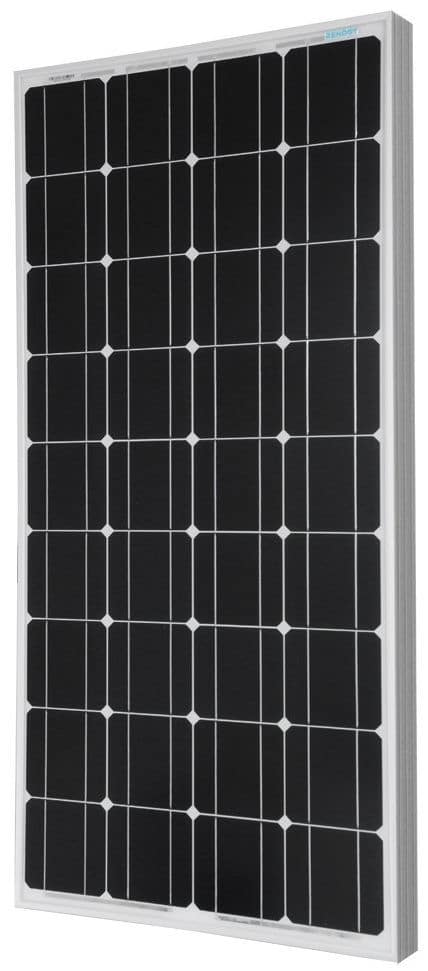
Connecting Solar Panels Together
How to Connect Solar Panels Together
![]() Connecting solar panels together is a simple and effective way of increasing your solar power capabilities. Going green is a great idea, and as the sun is our ultimate power source, it makes sense to utilize this energy to power our homes. As solar power becomes more accessible, more and more homeowners are buying photovoltaic solar panels.
Connecting solar panels together is a simple and effective way of increasing your solar power capabilities. Going green is a great idea, and as the sun is our ultimate power source, it makes sense to utilize this energy to power our homes. As solar power becomes more accessible, more and more homeowners are buying photovoltaic solar panels.
However, these photovoltaic solar panels can be very costly so buying them over time helps to spread the cost. But the problem then becomes how do we connect these extra solar panels together to increase the voltage and power output of what’s already there.
The trick here when connecting solar panels together is to choose a connection method that is going to give you the most energy efficient configuration for your particular requirements.
Connecting solar panels together can seem like a daunting task when you first start to look at how it should be done, but connecting multiple solar panels together is not that hard with a little thought. Wiring solar panels together in either parallel or series combinations to make larger arrays is an often overlooked, yet completely essential part of any well designed solar power system.
There are three basic but very different ways of connecting solar panels together and each connection method is designed for a specific purpose. For example, to produce more output voltage or to produce more current.
Solar photovoltaic panels can be electrically connected together in series to increase the voltage output, or they can be connected together in parallel to increase the output amperage. Solar pv panels can also be wired together in both series and parallel combinations to increase both the output voltage and current to produce a higher wattage array.
Whether you are connecting two or more solar panels, as long as you understand the basic principles of how connecting multiple solar panels together increases power and how each of these wiring methods works, you can easily decide on how to wire your own panels together. After all connecting solar panels together correctly can greatly improve the efficiency of your solar system.
Connecting Solar Panels Together in Series
The first method we will look at for connecting solar panels together is what’s known as “Series Wiring“. The electrical connection of solar panels in series increases the total system output voltage. Series connected solar panels are generally used when you have a grid connected inverter or charge controller that requires 24 volts or more. To series wire the panels together you connect the positive terminal to the negative terminal of each panel until you are left with a single positive and negative connection.
Solar panels in series add up or sum the voltages produced by each individual panel, giving the total output voltage of the array as shown.
Solar Panels in Series of Same Characteristics
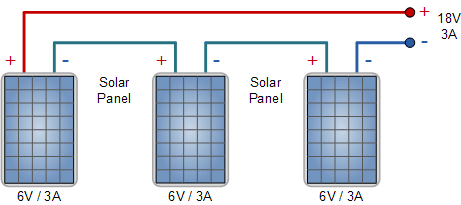
In this method ALL the solar panels are of the same type and power rating. The total voltage output becomes the sum of the voltage output of each panel. Using the same three 6 volt, 3.0 amp panels from above, we can see that when these pv panels are connected together in series, the array will produce an output voltage of 18 Volts (6 + 6 + 6) at 3.0 Amperes, giving 54 Watts (volts x amps) at full sun.
Now lets look at connecting solar panels in series with different nominal voltages but with identical current ratings.
Solar Panels in Series of Different Voltages
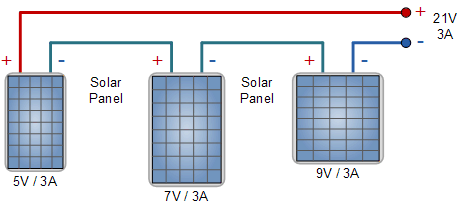
In this method all the solar panels are of different types and power rating but have a common current rating. When they are connected together in series, the array produces 21 volts at 3.0 amps, or 63 watts. Again the output amperage will remain the same as before at 3.0 amps but the voltage output jumps to 21 volts (5 + 7 + 9) .
Finally, lets look at connecting solar panels in series with completely different nominal voltages and different current ratings.
Solar Panels in Series of Different Currents
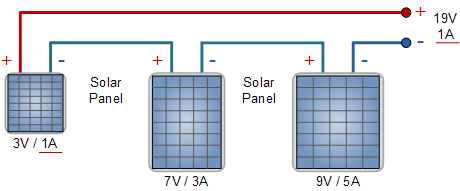
In this method all the solar panels are of different types and power rating. The individual panel voltages will add together as before, but this time the amperage will be limited to the value of the lowest panel in the series string, in this case 1 Ampere. Then the array will produce 19 Volts (3 + 7 + 9) at 1.0 Ampere only, or only 19 watts out of a possible 69 watts available reducing the arrays efficiency.
We can see that the solar panel rated at 9 volts, 5 amps, will only use one fifth or 20% of its maximum current potential reducing its efficiency and wasting money on the purchase of this solar panel. Connecting solar panels in series with different current ratings should only be used provisionally, as the solar panel with the lowest rated current determines the current output of the whole array.
Connecting Solar Panels Together in Parallel
The next method we will look at of connecting solar panels together is what’s known as “Parallel Wiring“. Connecting solar panels together in parallel is used to boost the total system current and is the reverse of the series connection. For parallel connected solar panels you connect all the positive terminals together (positive to positive) and all of the negative terminals together (negative to negative) until you are left with a single positive and negative connection to attach to your regulator and batteries.
When you connect solar panels together in parallel, the total voltage output remains the same as it would for a single panel, but the output current becomes the sum of the output of each panel as shown.
Solar Panels in Parallel of Same Characteristics
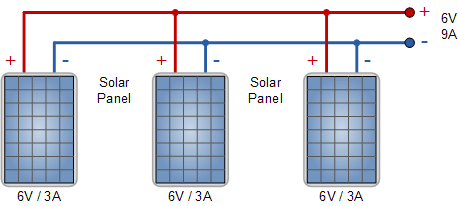
In this method ALL the solar panels are of the same type and power rating. Using the same three 6 Volt, 3.0 Amp panels as above, the total output of the panels, when connected together in parallel, the output voltage still remains at the same value of 6 volts, but the total amperage has now increased to 9.0 Amperes (3 + 3 + 3), producing 54 watts at full sun.
But what if our newly acquired solar panels are non-identical, how will this affect the other panels. We have seen that the currents add together, so no real problem there, just as long as the panel voltages are the same and the output voltage remains constant. Lets look at connecting solar panels in parallel with different nominal voltages and different current ratings.
Solar Panels in Parallel with Different Voltages and Currents
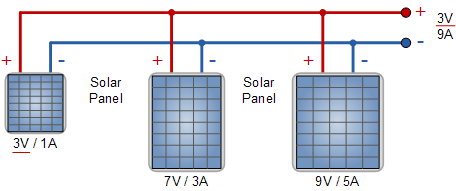
Here the parallel currents add up as before but the voltage adjusts to the lowest value, in this case 3 volts or some voltage value very close to 3 volts. Solar panels must have the same output voltage to be useful in parallel. If one panel has a higher voltage it will supply the load current to the degree that its output voltage drops to that of the lower voltage panel.
We can see that the solar panel rated at 9 volts, 5 amps, will only operate at a maximum voltage of 3 volts as its operation is being influenced by the smaller panel, reducing its efficiency and wasting money on the purchase of this higher power solar panel. Connecting solar panels in parallel with different voltage ratings is not recommended as the solar panel with the lowest rated voltage determines the voltage output of the whole array.
Then when connecting solar panels together in parallel it is important that they ALL have the same nominal voltage value, but it is not necessary that they have the same ampere value.
Connecting Solar Panels Together Summary
Connecting solar panels together to form bigger arrays is not all that complicated. How many series or parallel strings of panels you make up per array depends on what amount of voltage and current you are aiming for. If you are designing a 12 volt battery charging system than parallel wiring is perfect. If you are looking at a higher voltage grid connected system, than you’re probably going to want to go with a series or series-parallel combination depending on the number of solar panels you have.
But for a simple reference in regards to how to connect solar panels together in either parallel or series wiring configurations, just remember that parallel wiring = more amperes, and series wiring = more voltage, and with the right type and combination of solar panels you can power just about any electrical device you may have in your home.
For more information about Connecting Solar Panels Together in either series or parallel combinations, or to obtain more information about the different types of solar panels available, or to explore the advantages and disadvantages of using solar power in your home, then Click Here to order your copy from Amazon today and learn more about designing, wiring and installing off-grid photovoltaic solar electric systems in your home.





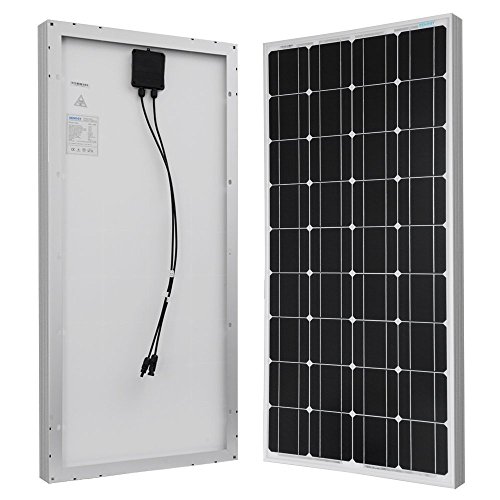





This is my thought I don’t live in a sunny climate and figure the panels won’t get full sun . So if it is cloudy all the time the panels may only put out half the voltage if I put them in series I would get the 12 -14 volts needed to charge the batteries even if they only put out half the voltage each. Does this sound reasonable ?
Have 2 100 w panels to charge 12 volt battery for camper in not so sunny Vancouver.
Solar panels give out their maximum wattage at full sun, but can also produce an output during daylight hours at reduced solar levels. For example, 100 W (PV panel) exposed to 1 hour of full sun (1000 Wh/m2) equals 100 Wh of electricity, whereas a panel exposed to half sun (500 Wh/m2) for 2 hours would also produce 100 Wh of electricity.
The other advantage of cloudy or overcast conditions is that photovoltaic panels can convert the sunlight into electricity more efficiently at lower temperatures, so your reduction may not be too great.
So parallel of panel more charges the battery than the series
To charge a bettery ampere is important or voltage
Amperage charges the battery.
I have 3 250w solar panel collected in parallel with 30a charger controller with 2 battery 12v in parallel and given me 24.9v 17.5a it is ok
i have two 150 watt 12 volts solar panels and on chagre controller charging through solar panel is 2.0 amp is this normal?
Sir I have 4 panels of 150 amp 12 v and two 240 amp batteries I connected two panels ( positive to positive and neg to beg ) to one battery is this the correct way or should I connect them all together in series or parallal way to get more power?
Regards
You will not get more power than the ratings of the panels no matter how you connect them, series or parallel connection depends on your setup.
I have 22 SP Each are 28.9 V (because they measure 30v) 8.2 Amp & 240 Watts What di you suggest for usage & whatcontroller do you suggest
Which one is the best connection between series and paralle connection?
hi im looking at doing 190w panels series (2 x 36.6v= 73.2) then in parallel of 6 at 5.5 amps. do i need to worry about the amps being to high? setting up 48v system to 240v .
No, use cable sizes to suit DC amperage.
Sir
i have 2 solar panels rated 17. 90V, 8.40A connected parraller.
My question is how much output it will give me on fully bright sun
17.9V x 16.8A = 300 watts at full sun
I am hooking up solar for camp. I have (2) 216w, 9.3a, 23v solar panels. I am running them through a 30a charge controller to (2) 12v batteries in parallel. Is it best to hook the panels in series or parallel?
Thanks,
Forrest
It depends on the input rating of your charge controller, but a parallel combination will give you twice the current for charging the batteies.
hello administrarot.!
i have 4 -250watts panel and i wired them in series and also i have 2 -200 Ah battries which are also wired in series and having 24 volt inverter of 3kv . so my question is that in how much time it takes to charge my battries?
thanks in advance
There are many factors that affect the charging time of batteries, the availability of sunlight for one.
Thanks for your excellent article on wiring solar panels. A friend and I are discussing what happens with like 24v nominal panels wired in parallel or series with an MPPT controller if one panel’s output is seriously degraded by shading. My understanding is that if wired in series current output of all panels will be reduced to that of the shaded panel. If in parallel only shaded panel’s current output will be reduced. Therefore if shading on one or more panels might be a problem best to wire in parallel. Can you confirm or not?
Shading, either partial or full, can greatly reduce the power output of a solar panel, and in severe cases can run the risk of hot spot formation. A photovoltaic cell in the dark behaves as a diode under forward bias acting as a short circuit.
If connected in a series configuration, the good cells bias the shaded cell so large amounts of power is dumped into the shaded cell as shaded cells do not add to the power produced, but they absorb it. A bypass diode across the photovoltaic cell limits the voltage across it when shaded, but any bypass diodes must be rated to take total possible series current.
Parallel shaded cells, when connected directly to a battery, will provide a short circuit discharge path for the battery. This high reverse current can be stopped by the use of a blocking diode. Blocking diodes also prevent back charging of the battery at night as the diode prevents charge coming back from the battery to the cell, or panel.
Then if the solar panel, or array is protected by both bypass and blocking diodes, any shading will have minimal efficiency loss whatever the configuration.
Check out page…………Solar Infra Technologies….on Facebook
We are looking for investors and partners for growth and expansion.
Hi, what would work better in charging batteries in my RV 3-100 watt panels or 1-300 watt panel?
1 x 300 watt panel, less space, less wiring, single alignment.
I have installed three each 12v 150w 10amp solar panels. This should be 12v 450w 30amps. But the max amps i get to charge batteries at peek hours (15v while connected to batteries) is 12.5amps. this equals 12.5A×15v=187watts. Why I am not getting 450watts of power?
There could be a number of factors why you are not seeing full power, the panels are not receiving full sun, they maybe badly aligned, sun strength is low, or your batteries are only drawing the amount of power they required to charge. Just because your array has a potential maximum power of 450W, does not mean it will deliver 450W continuously.
If I connect solar panel of the same volt and amp in series to a bty of two 12 volt also connected in series,what ll happen to my eqpt
connecting solar panels in series or parallel increases the voltage or current respectively but do the panel embedded wiring with mc4 connectors bears the increased voltage or current? say for some 50 or 100 solar panels are connected in a combination of series or parallel?
I have wired 4 small solar panels, Voltage: 5V Current: 160mA, in parallel but the amps have not gone up. Help
Hi , I am an electrician by profession and running a small electrical contract here in Kokopo,East New Britain Province, Papua New Guinea.
My focus now is to really know inside out of these solar systems and all its features including all its calculations .
I have 2 solar panels one 80 watts =17.5 V =4.571 A and the another solar panel that is 160 W =18.73 volts =8.62 A I plan on wearing them in parallel, as I believe that is my best choice correct.. which will give me 13.191 amps but will only have 17.5 volts and these will be wired to a 12 volt 30 amp /400 watt max PWM charge controller, I guess my question is losing that 1.23 volts, would it be a great loss when charging my two 6 V batteries I have in the series which is giving me 12 V to my RV thank you.
No, your charge controller will control the 12 volt charge to your batteries. The values you have quoted are maximum open-circuit voltage (Voc) and short-circuited current (Isc) values which will not occur if they are connected to the charge controller.
Actually no, I quoted the (Vmp) maximum power voltage and (Imp) Maximum power current. But anyways I should be fine then you think with putting a 160 watt solar panel in parallel with an 80 W solar panel? Thank you!
I would love to see a video of someone connecting the solar panels in parallel. I have 3 100 watt 12volt panels and 2 marine batteries (12 volt 135 AH and 165 AH). The batteries are connected in parallel. I have two 12 volt 30 amp controllers and a 2300 watt inverter for an off the grid system.
YouTube is full of videos showing how to connect solar panels together.
Hi
I purchased an off grid cabin with a rudimentary solar system consisting of 3 dead 12 volt/100 watt panels. A Xantrex c35 amp charge controller, Trace 24/12 inverter and 8 200ah batteries.
My question is I purchased 4 165watt panels to replace dead ones, they have 9.12 amp peak rating, which puts them above the rating of my ch/controller when wired in parallel. What size wire would be required to run from the panels, or could I use a 2nd ch/controller. Unfortunately the 12 volt system is what I’m stuck with fight now, is there some way to wire this setup to use all the panels. Thanks
Why use all four panels when three would give you what you want within the limits of the controller. The size of cable depends not only on amperage but cable length and percentage voltage drop for a DC system. The minimum you need for 12V 30A is 25mm2 (4 AWG) but this would increase with longer cable runs and lower percentage cable voltage drop, that is between 2% and 5% etc.
Please how to connect my 36panels 320w. 4panels in series and 9 strings in parallel. Thanks
Thank you very much for this information.I have read a lesent something important.I had a question though. I have one solar panel 153Watts that I am currently using to charge two 150 amp batteries that are connected in parallel. I recently bought another panel that is 153 wats. What’s is the best way to conect it with the other panel? Series or parallel and considering that my batteries are already connested in parallel would that make a difference?
The inter-connection of your solar panels would depend on the characteristics of your battery charge controller, series panels would give you a higher voltage, while parallel panels would give you a higher charging current.
What would be the optimal serial/parallel panel arrangement to address what I believe is a shading issue?
I recently installed an interconnected-to-the-grid solar array and am noticing a significant drop in the harvested kWh.
So this is what I have: 10 (Ten) 250-watt solar panels (open circuit voltage rated at 35 volts; all of them wired as a single serial string) 1 ThinkPower 2200 watt central inverter with max input of 13 amps and 500 volts, 1 MMP tracker
So I had everything installed in September (I’m in the northern hemisphere); during the first days/weeks I was generating as much as 14-15 kWh per day. As year has passed I’m currently generating 5-8 kWh per day. At this rate, I’d be surprised if I’m generating more than 2-4 kWh per day at the peak of the winter.
Here’s another piece of information that’s important: two of the panels are shaded. When the panels were installed the shading was minimum if any, but as we get closer to the winter I’m thinking the shading could be as much as 40% of these two panels during noon time.
I was wondering if I by re-arranging the panels into several series in parallel I could isolate/optimize the array so as to minimize the degrading effect of the shading.
Perhaps I could split my single string into two 5-panel serial strings connected in parallel hopes I may isolate the shaded two panels? Perhaps I should remove the two shaded panels altogether and stay with a serial string of 8 panels? Removing the source of the shading is not feasible (refer to this image:
Input greatly appreciated.
Thanks.
This a tech Battery Query! I have a charger/inverter all on a batt.box-80Ah! Have since secured from same vendor another 80Ah batt in an effort for longer power intervals of med. Equip. Am wanting to again expand to another batt. not from Vendor(excessive expense) Would it be detrimental to my system to olace a 100 Ah batt. in the array? Would the 100Ah ever become fully charged as do the other two from the attached solar panels(2-100watt)?
Thanks a bunch for any aid you can send this old retired cripple! W. Basham
It depends on how you connect the batteries. In a series configuration the 100Ah will only charge to 80Ah. This is because as the 80Ah battery reaches its fully charged state the charging current which is common to ALL batteries in a series chain reduces to a very small trickle charge and is insufficient to full charge the 100Ah battery. In a parallel configuration however, both the 80Ah and the 100Ah batteries will charge fully.
In lieu of using a heavier gauge wire from my panels to my controller, I intend to use all 3 wires in a 14 gauge cord for the positive connection and all 3 in a 2nd length for the negative connection. Is this beneficial even though the 3 wires in each length are insulated from each other?
Doubling or trebling up of cables to carry greater currents is ok as long as they are the same diameter (gauge) and correctly terminated together at each end, whether in a single crimp connector or individually bolted together. The fact that they are individually insulated does not matter. But remember that 3 cables will carry one third of the current each, but if one cable fails the remaining two will have to carry half the current each which may exceed their rating. Also cables used for solar panels are usually double insulated to protect from mechanical damage, sun and weather exposure.
Thanks. Very helpful.
i have 2*70watts solar panels and a 250 watts solar panel, which charge a 12v 200Ah battery. which solar configuration will give me the shortest time to charge the battery
Hello. Can same solar panel be used for water pumping and electricity generation together
Yes if its wattage is sufficient. This tutorial about Solar Gardens may help, or give ideas.
Sir
I have learned a lot .
I can now connect my 3 batterys in parallel to 2 solar panels .
Now this batterys are car batterys 120 h each, is it ok ?
Should be, why not.
One more question.Between Amperage and Voltage,Which one charges batteries?I was taking a look at my control unit and realized that on a rainy day the voltage coming in is 12 but 0 Amps.can a battery charge in such a scenario?Thank you
Current in amps charges batteries as they convert the electrical energy into chemical energy.
Thank you.I decided to connect my three batteries in parallel but then I have set up my two solar panels (120W and 200W) in a way that each is on its own.The first panel (200W) is connected to 15A charge controller while the other one (120W) is connected to a 5A Charge controller and both the outputs from the two charge controllers have been connected to the batteries.is the connection harmful to the batterries in any way?
Hi, I have two solar panels (120W and 200W) and three 12v100a batteries,two charge control units-24v and 12v.what is the best connection that will charge my batteries fully at the same time?If I connected the panels in series but put the one with a higher output in front will the power drop?Thank you
You only have two panels, so series = 24V and parallel = 12V. (assuming 12V panels, as not stated)
3 batteries in series = 36V which is too high, 3 batteries in parallel = 12V.
Then a 12V system is required to charge all three batteries at the same time.
Thanks alot.
I have two (2) 60w x 3.33A /w/ charge controller (suitcase type) – and two (2) 50w x 2.78A with charge controller (another suitcase type). Do I connect them in series or parallel? My thought is “series”.
I drew myself a schematic of what I think. All my solar panels are rated @ 12volts so the voltage remains the same. Correct? And amp ratings differ but I add those together to get a total amperage rating. Correct?
And amp ratings on the all panels are 3.33A each x 2 – and 2.78A each x 2. That gives me a total (added together) amperage rating of 12.2Amps.
Are my calculations correct or wrong if wired in “series”?
With your 4 panels (2 x 12V, 3.33A and 2 x 12V, 2.78A) conected in “series”, the total voltage will be 48V (4 x 12) at 2.78A, as this is the lowest amperage.
With your 4 panels connected in “parallel”, the voltage will be 12V, but the amperage will be 12.2A (3.33 + 3.33 + 2.78 + 2.78).
I HAVE A 140 WATT MOUNT ON THE TOP OF MY R.V… I WANT TO GET A 200 WATT FREE STANDING, WITH A 15 AMP BATT CONTROLLER ON IT (SUIT CASE TYPE) . COMES WITH BATT CLAMPS CAN I HOOK IT TO THE BATTERIES.. 4 – 6 VOLT TIED IN TOGETHER. WITHOUT DAMAGE TO THE BATTERIES OR THE 140.. IF NOT WHAT DO I NEED TO DO… THANKS FOR YOUR TIME & HELP..
Yes you can feed both panels into your battery bank providing you connect the positive and negative terminals correctly, and your 140W RV panel is also regulated by a charge controller. This will protect the battery bank against excessive charging.
Sir
I have two solar panels of 150 watts and battery of 12 v 100 amp.i want to charge my battery as soon as possible what method i will adopt i.e serious or parallel….
You only have two solar panels so connecting them together in parallel will give a higher current output.
English only
Consult a specialist in your area.
Off the cuff, I would say 2000 watts of panels might give you one KVA. It all boils down to efficiency. Panel efficiency times inverter efficiency times load efficiency and installation efficiency. Multiply it all together and you might end up with half the input as output plus further losses will occurr where inductive loads can cause a low overall power factor in the installation.
An interesting Hybrid Solar charger “Infini” has a high VOC (Open circuit voltage). This provides for a series circuit where cable sizes can be small and losses are very low in the higher voltage circuit. Wiring is simplified as you just plug the panels from panel one to panel 2 etc from the first to the last panel. Connect one wire to each end ( + and -) down to the Infini controller.
The Infini controller has many modes: Grid tie, Off grid, On grid with battery backup and more. If you add all your panels watts, say Ten 250 watt panels this totals 2500 watts DC Input. The amps in a series circuit is that shown on one panel where all are identical.
KVA is related to AC output where volts times amps = watts at unity power factor. Basically relates to the total load power factor of the whole load. If it is 0.8 power factor then a Ten KVA alternator will only deliver 8KVA, etc.
Care is needed with electric motors. You should use capacitor run motors of high power factor and high efficiency. Motor types: PSC (capacitor run) Dual cap motors in larger sizes (Cap start, cap run) and often PSC.
WOW just what I was searching for. Came here by searching for connecting solar panels together
Dear Sir,
Kindly show me a simple formula for calculating the following:
1)How many panels are required for generating 1KVA power.
2)Sunlight at our area is 5 hours.
3)Backup required is 8 hours.
4)What will be the Panel size.(Watt peak).
Also would appreciate if you could show me a how to calculate the same in future with different capacities ..
I came with another question, consider that the voltage of a battery bank is 48 V-800 AH, and a 4000W inverter which is equipped with MPPT solar charge controller with below specification, is used to invert the DC voltage to AC:
1- Solar cahrger
Maximum PV array open circuit voltage 145 VDC
MPPT operation voltage range 60-115 VDC
Maximum charging current 60 A
2- Battery
Battery voltage 48 V DC
floating charge voltage 54 VDC
maximum utility charging current 60A
How much should be the voltage of solar panels? I have nine 250 W panel with 30.69 Vmp and 38.7 Voc.
Thanks in advance
An array of 3 by 3 panels
I am working on a project with nine 250 watt panels (Vmp=30 V), and 16 flooded/wet lead acid batteries (6 V, 370 AH @ C20). I want to connect the batteries 4 by 4 in series to reach 24 VDC, and then connect them in parallel to reach 1480 AH.I will use a 24 VDC to 230 VAC inverter; now to charge the battery bank properly, how should I connect the panels, series or parallel?
I have another option for my batteries, to use 16 Solar Gel Deep Cycle batteries (12V, 200AH @ C20), the cycle life of each battery for both options are 1200. Although the second option will produce more wattage (16*12*200=38400 w), but I think the life of first option is longer. Please correct me if I am wrong.
Regarding option one. To produce 24v you will need four 6V batteries in series, giving a 4 by 4 array. The power available from the array would therefore be: 24V, 1480A (4 x 370A) giving 24V x 1480A = 35.5kWh.
For option two, to produce 24V you will need two 12V batteries in series, giving a 2 by 8 array. Then the power available would be: 24V, 1600A (8 x 200A) giving 24V x 1600A = 38.4kWh. While option two produces more available power, the life span of either option would depend on the demand and the charge-discharge cycle of the array.
what if you connect 3 panels with same voltage in series and then connect a 4 panel in parallel to the series, what is the voltage and the amperage of the system? if 1 panel has 30.5v at 8 amps. 3 x 30.5v = 91.5vdc and this is connected to the 4 panels that is in parallel. what is the voltage and the amperage?
hi there, great tutorial, I have two 40 watt panels I will run through 1 charge controller in series, there is another panel I will get that is 38 watts. The 40’s are identical at 17.1 volts, 2.3 amps but the 38 watt is 21.1 at 1.8 amps. My question is; if I set up the two 40 watt units in series and connect to RV battery to enjoy the increased wattage but then also clamp the 38 watt unit to the battery quite separately, will it still reduce the overall charge the batteries receive? I understand that connecting the lower amp unit will reduce output if set in series with the higher amperage units. Cheers
Hello Dan, If you connect the three solar panels in series to feed the charge controller, then the series current fed to the controller will be 38v at 1.8amps, the lower value. If you really need to add a third panel, you could keep your two existing 40W panels in series feeding the controller which in turn feeds the battery, but add the 38W panel in parallel with the output from the controller using a blocking diode to prevent feedback. That way you could potentially have 2.3 + 1.8 = 4 amps charging the battery but the smaller panel would be unregulated.
I have a question that if I want to operate a water pump and a referegrator at my home what is your advise to use how many solar panels and how many battries and how to connect them with thanks
Thank you for this very vague question. What is the power and voltage rating of your appliances, how long should they run throughout the day, is it an on-grid or off-grid installation, etc, etc.
Earth4Energy is a comprehensive guidebook that gives details on ways to construct solar panels as well as wind turbines. It was stated to have actually assisted folks saved around 80 % of their money on power bills.
I have an opportunity to buy 15 60 watt panels that are from the early 1990’s still in the crate. I want to use them for off grid for a small camp powering 12 volt batteries. They are actually 6 volt golf car deep cycle batteries and i just bought two to start and will add as many as i need to run these 15 panels but i am not sure what i need as far as controllers , size power inverter, size wire 10awg ? I wonder if i need to wire a 10 amp fuse on each individual panel incase of an overload. I am located in upstate NY and will be using the system to power a small college dorm size frig 5 watt led lights 10 at the most a few box fans and charge power tools and a small dc water pump. Can you help me figure out how to wire them and what i need to get the whole system up and running safely? Thank you for your time and help with this matter
thanks a lot for the information…i’m planning to have my own solar panel..
A really nice, well explained article.
Many thanks.
Thank you for the kind comment, glad you like it.
Connecting together solar panels can be difficult if they are not of the same voltage and current ratings. Many people think that if they have a panel of 50W and one of 200W then they will have a 250W system but as shown above this is not always the case as differences in voltages and current ratings reduce an arrays efficiency. 😉
Hello,
I am a newbie to this site and have been reading stuff for days. Thank you so much for all the great info.:)
I have a 24v system, 8 T105’s in a series/parallel configuration, 2800 watt Magnum inverter at a remote camp off grid.
I have 6 solar panels now and will be adding 6 more soon as the are on the way now. The 6 panels are configured (2 panels in series, 3 strings paralleled) as follows
2 Kyocera 120 watt in series with a Voc 21.5v, Vmp 16.9v, Isc 7.45a, Imp 7.1a these are paralleled with 2 strings of 2 DM solar 145 watt in series with a Voc 21.7v?, Vmp 18.0v, Isc 8.48a?, Imp 8.0a (I am sure of the Vmp & Imp, guessing on the Voc & Isc)
Based on what I have read here, connecting panels in series you look a the difference in current and when connecting in parallel, you look at voltage. The above configuration seemed to yield the most out of the panels. If I add 6 more DM solar 145 watt panels and configure the 6 additional panels as 3 more strings like above, I will have a current of 47 – 48 amps. If I go this way I will have to change my 70 foot run of #6 copper to something bigger which I am OK with if it makes sense. If I do could I use a #2 URD cable as it has 4 conductors (3 – #2’s & 1 – #4) so I could do a parallel thing. I am planning on buying the MidNite Classic 150 but could buy the 200 or 250 if it makes sense to you guys that I instead put more panels in series. I didn’t know how to configure because if I put 5 DM solar 145’s and 1 Kyocera 120 in a string then wouldn’t all panels in the string be capped at 7.1 amps which I would lose about 80 watts per string?
I greatly appreciate your thoughts 😉
Scott